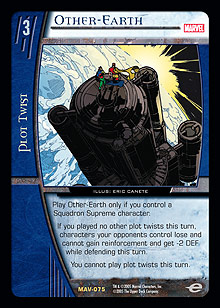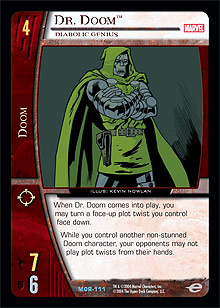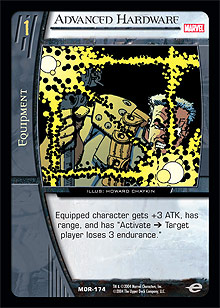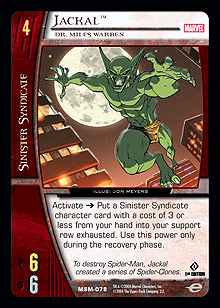Ten Team Child Lock
 The Bremen $10K was the first major Golden Age tournament after Pro Circuit Los Angeles 2005, but it was also the inaugural event for the Justice League set. Generally, a Pro Circuit Champion’s deck is heavily played at the first event following his or her victory, but only five New School decks were played at $10K Bremen. Avengers and Squadron Supreme were the most popular decks, followed closely by Common Enemy. As a result of the extermination of Sentinels, Common Enemy was finally able to break into the top three after lingering in the middle of the metagame breakdown for months. There was tons of diversity in the Top 8, which included a Masters of Evil / Green Lantern / Emerald Enemies deck and a Doom Team Tactics deck. A Both Guns Blazing build managed to secure fourth place after Day 1 in the hands of Raphael Pitchal. In his quarterfinal match, Pitchal ended up losing to Philip Korber’s Squadron deck, probably as a result of Other-Earth breaking the Child lock. Squadron emerged victorious from the final showdown against Avengers, turning the rule of card advantage on its head.
The Bremen $10K was the first major Golden Age tournament after Pro Circuit Los Angeles 2005, but it was also the inaugural event for the Justice League set. Generally, a Pro Circuit Champion’s deck is heavily played at the first event following his or her victory, but only five New School decks were played at $10K Bremen. Avengers and Squadron Supreme were the most popular decks, followed closely by Common Enemy. As a result of the extermination of Sentinels, Common Enemy was finally able to break into the top three after lingering in the middle of the metagame breakdown for months. There was tons of diversity in the Top 8, which included a Masters of Evil / Green Lantern / Emerald Enemies deck and a Doom Team Tactics deck. A Both Guns Blazing build managed to secure fourth place after Day 1 in the hands of Raphael Pitchal. In his quarterfinal match, Pitchal ended up losing to Philip Korber’s Squadron deck, probably as a result of Other-Earth breaking the Child lock. Squadron emerged victorious from the final showdown against Avengers, turning the rule of card advantage on its head.
The metagame was beginning to shift from Sentinels / Titans to Avengers / Squadron, which was evident from the turnout at $10K Sydney. This $10K did include a few new surprises, though, such as a JLA / JLI team-up dubbed “Good Guys” and an increase in the popularity of Patrick Yapjoco’s G’Lock deck. Good Guys was a rush deck centered around the ally ability that could turn mere power-ups into +4 ATK / +2 DEF pumps, while G’Lock was a defensive version of GLEE that stalled using endurance gain to get to the later stages of the game.
The biggest story of $10K Sydney was Kakarot Turker’s Child Lock deck. Turker said that he intended to call his deck “Clock” (Child + Lock = Clock) but felt that it was too generic. The common name for his deck is Ten Team Child Lock, shortened to Ten Team by other players. Ten Team is a burn deck that plays numerous search effects to create a giant toolbox of character and non-character cards alike. By using Flamethrower and Melissa Gold ◊ Screaming Mimi, Ten Team can easily end the game without ever engaging in combat. This deck is the most varied and unique Child Lock deck available because instead of limiting itself to a set number of teams, it can play any low cost character and reliably search it out. As the name implies, this deck was originally composed of ten different teams, unleashing a vast amount of diversity and versatility that players had never before seen in a Child Lock deck. For those interested, the teams included in the original Ten Team build were Masters of Evil, Gotham Knights, Doom, Fantastic Four, JLI, Injustice Gang, Arkham Inmates, Emerald Enemies, Spider-Friends, and Sinister Syndicate. (Technically, that’s eleven teams, but Arkham Inmates didn’t really count because Poison Ivy, Deadly Rose is dual-affiliated.) Ten Team was enabled by the new Justice League cards Kooey Kooey Kooey; Ted Kord ◊ Blue Beetle; and Poison Ivy, Deadly Rose. Child Lock now had the tools to search for any type of card in its deck, whether it was a character, plot twist, location, or equipment. But with all of those great search effects came dozens of decisions that needed to be made, and one wrong move could send your whole game plan down the drain. Ten Team punished inexperienced players pretty harshly, but in the hands of a capable pilot, it became a machine that tore through the field. Here is Kakarot Turker’s original list:
Kakarot Turker
$10K Sydney 2006
Ten Team Child Lock (Clock)
Characters:
1 Paul Ebersol ◊ Fixer, Problem Solver
1 Spoiler, Stephanie Brown
1 Boris, Personal Servant of Dr. Doom
4 Invisible Woman, The Invisible Girl
3 Ted Kord ◊ Blue Beetle
4 Beetle, Armorsmith
4 Mr. Fantastic, Reed Richards
1 Poison Ivy, Deadly Rose
1 Melissa Gold ◊ Screaming Mimi, Mimi Schwartz
1 L-Ron, Robot Companion
2 Fatality, Emerald Assassin
1 Black Cat, Master Thief
1 Rama-Tut
1 Alistair Smythe
4 Dr. Light, Master of Holograms
Plot Twists:
1 Foiled
1 Salvage
1 Ka-Boom!
4 The Ring Has Chosen
4 A Child Named Valeria
3 Vicarious Living
Locations:
1 Doomstadt
4 Kooey Kooey Kooey
1 Slaughter Swamp
3 Birthing Chamber
Equipment:
1 Utility Belt
2 Catcher’s Mitt
4 Flamethrower
 In the quarterfinals, Turker demolished Andrew Corney’s Marvel Knights / Anti-Matter deck because of Corney’s lack of out-of-combat tricks. In the semis, Turker defeated Lindsay Heming’s Common Enemy deck, which on paper was one of the worst matchups Turker could’ve faced. Heming ended up missing Dr. Doom, Diabolical Genius in both games, however, preventing him from being able to clear Turker’s board with Reign of Terror. With that stroke of luck, Turker advanced to the finals, where he faced Randall Hughes and his Teen Titans deck. Halfway through game 1, Turker decided to concede so that he could play in the PCQ that was starting soon; had the matches been played out, Hughes would likely have won anyway. Teen Titans still remained a bad matchup for Child Lock, and although the archetype faded briefly after PC: LA, it was beginning to make a comeback. Not a single Avengers or Squadron deck cracked the Top 8 at this event, which was a sign that change was on the horizon.
In the quarterfinals, Turker demolished Andrew Corney’s Marvel Knights / Anti-Matter deck because of Corney’s lack of out-of-combat tricks. In the semis, Turker defeated Lindsay Heming’s Common Enemy deck, which on paper was one of the worst matchups Turker could’ve faced. Heming ended up missing Dr. Doom, Diabolical Genius in both games, however, preventing him from being able to clear Turker’s board with Reign of Terror. With that stroke of luck, Turker advanced to the finals, where he faced Randall Hughes and his Teen Titans deck. Halfway through game 1, Turker decided to concede so that he could play in the PCQ that was starting soon; had the matches been played out, Hughes would likely have won anyway. Teen Titans still remained a bad matchup for Child Lock, and although the archetype faded briefly after PC: LA, it was beginning to make a comeback. Not a single Avengers or Squadron deck cracked the Top 8 at this event, which was a sign that change was on the horizon.
The High Voltage Era
Avengers began to decline at $10K San Francisco, while G’Lock was becoming increasingly popular. The majority of the field was composed of Squadron and Titans, but G’Lock and a new Anti-Green Lantern rush deck followed closely behind. The diversity of this tournament was shocking, with over thirty different archetypes represented. Only a single Child Lock deck showed up, and although it started off 5-0, it failed to make the Top 8 cut. Instead, the Top 8 consisted of three Titans decks, three AGL decks, an updated X-Stall deck, and a lone G’Lock deck. Titans proved that it was the most consistent deck in the history of Vs. System when it nabbed yet another $10K win in the hands of Josh Wiitanen. Ever since its first victory at the $10K event attached to the inaugural Pro Circuit, Titans has never faltered, and it will likely always remain a strong competitor in any Golden Age metagame.
During the semifinals match between Wiitanen and Patrick Yapjoco’s G’Lock deck, Patrick made an error in the decisive game 3. Yapjoco accidentally discarded his only 7-drop to Book of Oa and was forced to play a 1-drop on turn 7, which arguably lost him the match. Many players believe that had he not discarded his only 7-drop on turn 7 to Book of Oa, he would’ve beaten Wiitanen and possibly gone on to win the $10K. Either way, the metagame had shifted back toward Titans and away from Avengers, which put Child Lock in a bad situation.
The hype from Pro Circuit Atlanta and the second Marvel Modern Age format was still lingering when $10K Auckland began. Most of the competitive player base had been too busy working on Marvel Modern Age to be concerned with Golden Age, and unbeknownst to them, $10K Auckland would be one of the most influential major Vs. events ever. Aside from being the first major Golden Age event in which The X-Men was legal, $10K Auckland would introduce one of the most popular and hated decks since Curve Sentinels. At first, the metagame breakdown looked pretty standard—Squadron, G’Lock, Good Guys, and some Teen Titans were at the top of the boards. By the conclusion of Day 1, though, the biggest story was Shaun Hayward’s High Voltage deck, which at first glance appeared to be a random collection of characters that shared no uniting theme or team affiliation. But players who had experienced High Voltage firsthand would tell you that it was more than just a pile of cards from the common box; it was a machine that could tear through any and every deck set in its path. A combination of burn effects such as Die for Darkseid!, Advanced Hardware, Surprise Attack, Golden Archer, and Flamethrower allowed the deck to cause massive amounts of damage both off and on initiative. High Voltage was like Squadron Supreme on steroids, although it lacked the grace and fluency that classic Squad lists managed to capture. Voltage may have looked a little crude, but once Hayward took home the $10K Auckland trophy, people were forced to give the deck a second glace. Hayward shredded through a Top 8 containing plenty of solid decks and players, thrusting Voltage onto the competitive scene for months to come.
Some players still believed that Hayward’s victory was a fluke, but the subsequent $10K Minneapolis showed them that they were wrong. Titans and Squadron still remained at the top of the metagame breakdown, but after the Top 8 cut, neither was anywhere to be seen. Old favorites had reemerged, including New School, X-Stall, Big Brotherhood with Nth Metal, and Avengers with a new toolbox build. Despite the diversity, High Voltage managed to come out on top once again. It was the real deal, and anyone who didn’t have an answer for it needed to find one before Pro Circuit Los Angeles 2006 in November.
 The metagame shifted drastically after $10K Minneapolis, with more and more players converting to Voltage because of its simplicity and explosiveness. Despite the increasing number of copies of Advanced Hardware seeing play, the Top 8 of $10K Brisbane managed to showcase eight different decks, including two Child Lock decks. Brisbane was also the first $10K at which Infinite Crisis was legal, and the set made an immediate impact when Bobby Rana landed his Shadowpact deck in the Top 8. Child Lock was one of the last decks expected to show up as an answer to Voltage; your opponent wouldn’t care about A Child Named Valeria because he or she could still burn you out. Shaun Hayward, the creator of High Voltage, opted to run Rigged Elections in an attempt to defeat his own Frankenstein through an alternate win condition, while Kakarot Turker brought his Ten Team list from $10K Sydney with a few alterations. Here’s Hayward’s updated Rigged Elections build from $10K Brisbane:
The metagame shifted drastically after $10K Minneapolis, with more and more players converting to Voltage because of its simplicity and explosiveness. Despite the increasing number of copies of Advanced Hardware seeing play, the Top 8 of $10K Brisbane managed to showcase eight different decks, including two Child Lock decks. Brisbane was also the first $10K at which Infinite Crisis was legal, and the set made an immediate impact when Bobby Rana landed his Shadowpact deck in the Top 8. Child Lock was one of the last decks expected to show up as an answer to Voltage; your opponent wouldn’t care about A Child Named Valeria because he or she could still burn you out. Shaun Hayward, the creator of High Voltage, opted to run Rigged Elections in an attempt to defeat his own Frankenstein through an alternate win condition, while Kakarot Turker brought his Ten Team list from $10K Sydney with a few alterations. Here’s Hayward’s updated Rigged Elections build from $10K Brisbane:
Shaun Hayward
$10K Brisbane
Rigged Elections
Characters:
1 Spoiler, Stephanie Brown
3 Micro-Chip
4 Mikado and Mosha
4 Dagger, Child of Light
4 Invisible Woman, The Invisible Girl
4 Alfred Pennyworth
3 GCPD Officer
1 Poison Ivy, Deadly Rose
1 Shimmer
3 Mr. Fantastic, Reed Richards
1 Dr. Light, Master of Holograms
1 Commissioner Gordon, James Gordon
Plot Twists:
2 Rigged Elections
2 Fizzle
3 Enemy of My Enemy
4 Wild Ride
4 Bat-Signal
4 Midnight Sons
4 A Child Named Valeria
4 Cosmic Radiation
Locations:
1 UN Building
Equipment:
1 Catcher’s Mitt
1 Utility Belt
Hayward lost to Bobby Rana’s Shadowpact deck in the quarterfinals, which was unfortunate because that was the worst matchup he could’ve gotten on Day 2: June Moon ◊ Enchantress, Good Witch and Total Anarchy can easily disrupt the Child Lock; The Conclave can negate search effects; and Cosmic Radiation can bring the entire combo to a halt. Turker lost to an interesting Green Lantern / Doom team-up piloted by Andrew Morris in the quarterfinals, probably because of both the endurance Morris gained from Katma Tui and the Reign of Terror that cleared Turker’s field. The final matchup pitted two unlikely competitors against each other, specifically Gloom and the Arkham Inmates / Brotherhood team-up deck. Alexander Antonios emerged victorious with Inmates / Brotherhood, which combined early game Mad Hatter / Poison Ivy, Deadly Rose antics to stop Voltage with the classic Big Brotherhood Lost City engine, aided by Harley Quinn. Unlike past dominant archetypes, Voltage already had some competition in the form of both Inmates / Brotherhood and X-Stall, which managed to defeat the lone Voltage deck in the Top 8. A new top tier deck had made its debut, but unlike Sentinels and Light Show, there were plenty of ways to handle it.
Golden Age $10K events began to fall farther and farther apart as calendar space was devoted to the new Silver Age format and Sealed Pack tournaments. When July rolled around, though, Boston brought everyone back to the game’s first and most diverse format. $10K Boston was expected to be a High Voltage fest, but the metagame breakdown revealed plenty of Titans, G’Lock, and Inmates / Brotherhood to go with all the direct endurance loss. The biggest story of this tournament was a deck meant to abuse Fiddler and Gone But Not Forgotten called Fiddler on the Roof. If you have one Fiddler in your KO’d pile, then you can play a second one, KO it, and return the first Fiddler to your hand. You can repeat this as many times as your resource points will allow, and if you have multiple copies of Gone But Not Forgotten in your resource row, then you can gain excessive amounts of endurance. Fiddler on the Roof didn’t make the Top 8, but the concept intrigued many players who were determined to find a more consistent build of the deck that could abuse the double-Fiddler interaction. The Top 8 yielded the typical collection of Titans and High Voltage, but Good Guys and Sentinels broke through the ranks as well. Everyone expected the finals to be Titans versus Voltage, but Nicolas Cuenca managed to pilot Good Guys to the chair opposite Yu-Ming Mo and High Voltage, eventually taking the $10K Boston championship. This victory by Good Guys elevated it to the status of Titans and High Voltage, and forced the deck into Golden Age testing gauntlets around the globe.
The Future
Whew! We’ve finally covered the entire history of Child Lock, which has spanned two years of competitive play and four Golden Age Pro Circuits. What happens next? If you haven’t been living under a rock, you know that the upcoming Pro Circuit stop in Los Angeles is going to be Golden Age. Golden Age hasn’t been the focus of many pro players’ attentions since the last PC: LA because of the three other rotating formats, but now that there are eleven sets, PC: LA is expected to be the most diverse metagame Vs. System has ever seen. As you can tell, Child Lock has been slowly fading away in recent tournaments, but that certainly doesn’t mean it has fallen out of contention.
To be competitive in Golden Age, any given deck has to have a game plan against High Voltage, Teen Titans, and Good Guys. You can probably get away with having a 50/50 matchup against one or two of those, but you have to be able to beat one of them at least 75% of the time. The big question now is what approach for handling these three decks Child Lock should take. The main Child Lock archetypes are stall, burn, and alternate win condition. I think it’s safe to rule out stall, because with fast decks in the metagame (like Voltage and Titans), dragging the game out to the later stages doesn’t seem like a feasible option. Alternate win condition could be viable, because not caring about damage from your opponent neutralizes Voltage’s main advantage. In the end, though, I think a Child Lock burn deck would be the most successful for the upcoming Golden Age season, as it’s much harder to disrupt than combo.
Antarctic Research Base was recently banned, which means that Fantastic Fun is no longer a viable Child Lock variant. The classic Common Enemy Child Lock burn deck is also a little too outdated to deal with the modern metagame, so that leaves Ten Team and Scarlet Witch, Eldritch Enchantress burn. I think that combining the two archetypes into a multi-team deck that utilizes a Team-Up like Rann to protect you from Betrayal is the best approach to take. The core of Turker’s most recent Ten Team build looks like the best starting point because most of the changes that are needed deal with the metagame and not the base of the deck.
 Both Voltage and Titans use a lot of payment powers, so Utility Belt should be an automatic four-of. In my honest opinion, Utility Belt is an amazing card; you’d be surprised how many people think payment powers are only present on plot twists. Utility Belt can negate tons of different effects in a wide variety of decks, and rumors are floating around online forums that there is still a plausible infinite combo besides the one involving Jackal previewed by Tom Reeve. If there is in fact an infinite loop hiding within the card pool, Utility Belt will more than likely be able to negate it. Even if you don’t know exactly what kinds of combo decks will show up at PC: LA, playing a full suite of Utility Belts will more than likely be enough to keep you safe. The new endurance gain cards from Heralds of Galactus, such as Galan and Worldeater Apparatus, could be used as an alternate solution against Voltage to stay in the game. Finally, with the insane amount of search effects available, you should be able to toolbox whatever card you want into your Child Lock deck and reliably search for it. The possibilities are endless, and with some dedicated testing and a bit of luck, you could easily write the next chapter in the Child Lock saga at PC: LA.
Both Voltage and Titans use a lot of payment powers, so Utility Belt should be an automatic four-of. In my honest opinion, Utility Belt is an amazing card; you’d be surprised how many people think payment powers are only present on plot twists. Utility Belt can negate tons of different effects in a wide variety of decks, and rumors are floating around online forums that there is still a plausible infinite combo besides the one involving Jackal previewed by Tom Reeve. If there is in fact an infinite loop hiding within the card pool, Utility Belt will more than likely be able to negate it. Even if you don’t know exactly what kinds of combo decks will show up at PC: LA, playing a full suite of Utility Belts will more than likely be enough to keep you safe. The new endurance gain cards from Heralds of Galactus, such as Galan and Worldeater Apparatus, could be used as an alternate solution against Voltage to stay in the game. Finally, with the insane amount of search effects available, you should be able to toolbox whatever card you want into your Child Lock deck and reliably search for it. The possibilities are endless, and with some dedicated testing and a bit of luck, you could easily write the next chapter in the Child Lock saga at PC: LA.
Unfortunately, I can’t provide you with any decklists of my own—it would violate the rules of my team—but I’ve hopefully provided you with enough information to get your innovative cogs turning, and maybe we’ll end up seeing a successful Child Lock variant at PC: LA. Thanks to everyone who stayed with me for the entire Child Lock series, and I hope that you’ve all learned something useful, either about the deck itself or the history of competitive Vs. System. Next week, I’ll be returning to my regular one-part deck analysis articles for Golden Age, reviewing old favorites and newer decks that you’ll be sure to see at PC: LA.
Graham Van Leeuwen is a fourteen-year-old high school student who lives in Chapel Hill, NC. He has seen a small amount of tournament success, including 5th place at $10K Charlotte 2006 and 50th place at Pro Circuit Atlanta, but has yet to land a big money finish. Graham is a member of Team No Quarter Given, a team based throughout North Carolina and Virginia. He can be contacted with questions, comments, complaints, or requests at gvl@nc.rr.com.